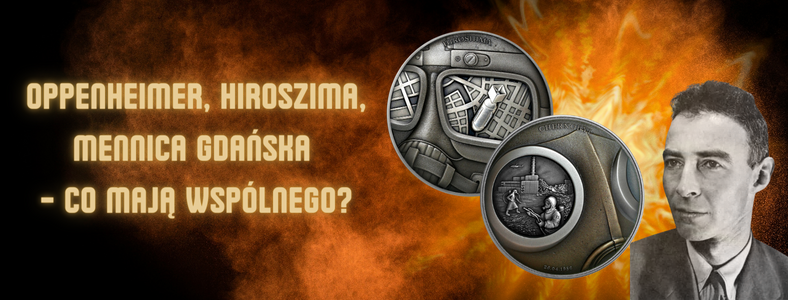
Oppenheimer, Hiroszima, Mint of Gdansk - what they have in common?
Julius Robert Oppenheimer - a prominent scientist, called the father of the atomic bomb. It was he who created the first powerful weapon, which was dropped in the attack on Hiroshima and Nagasaki in August 1945, taking thousands of lives. In an interview with U.S. President Harry Truman, he said: "Mr. President, I feel that I have blood on my hands." But do you know what Oppenheimer has to do with the Mint of Gdansk?
Oppenheimer, Hiroszima, Mint of Gdansk - what tjey have in common?
Julius Robert Oppenheimer played a key role in the Manhattan Project. This was a secret project run by the US government, the goal of which was to create precisely the atomic bomb. After the war, Oppenheimer was chief advisor to the newly formed Atomic Energy Commission and used his position to fight for international control of atomic energy and to prevent a nuclear arms race with the USSR. Because of his views on the matter, as well as his pre-war strong ties to the Communist movement, he was denied access to secret state documents during a public, political trial in 1954. After this event, he continued his activities, writing and lecturing. He also devoted more time to academic work. It was not until a decade later that President John F. Kennedy awarded him the Enrico Fermi Prize, politically rehabilitating him in the process.
Hiroshima at the Mint of Gdansk
The Gdansk Mint issued a series of "Human Tragedies" coins and Hiroshima was one of them. The reverse of the coin depicts a pilot's mask, in which the scene of the bomb drop on the Japanese city is reflected. The high relief makes all the details visible. .
Chernobyl disaster
Another, and actually the first coin in the series, is Chernobyl. The reverse of the coin depicts a liquidator's mask, which reflects the scene of cleaning up the area after the explosion. As a result of the complete destruction of the reactor, an area of 125,000 to 146,000 square kilometers of land on the border of Belarus, Ukraine and Russia was contaminated with radioactivity, and the radioactive cloud emitted from the damaged reactor spread throughout Europe. As a result of the contamination, more than 350,000 people (mainly from Pripyat) were evacuated and displaced. After the catastrophe, for political reasons, the USSR mainly exposed the fault of the reactor operators.
Touching obverses
The obverses of the coins are also incredibly impressive. On the first one, we see a destroyed city in the background. On the second one we see part of the destroyed Pripyat, with ghostly trees and an abandoned, gloomy-looking section of - nomen omen - an amusement park. The obverses also feature an image of the issuer - the island of Niue. Both coins have a fluorescent addition - they glow in the dark!
Click to see the "Human Tragedies" coin series.
Oppenheimer story film
On July 19, a film about the history and role of J.R. Oppenheimer, directed by Christopher Nolan in the creation of the atomic bomb, had its world premiere (July 21 in Poland). This is the first film ever to use black and white film in an IMAX camera to shoot some scenes. Have you already been to the cinema to see "Oppenheimer"?

All comments